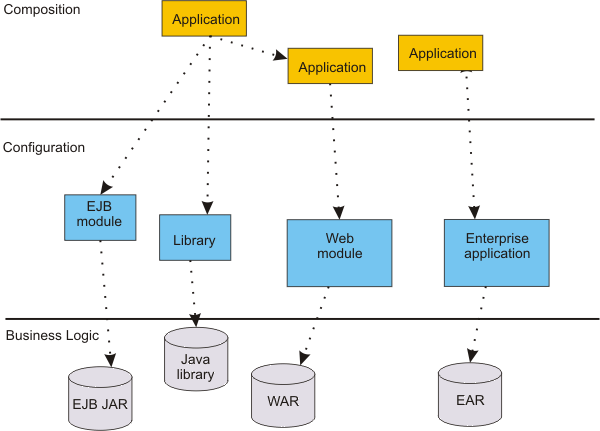Network Deployment (Distributed operating systems), v8.0 > Develop and deploying applications > Deploy and administering business-level applications
Business-level applications
A business-level application is an administration model that provides the entire definition of an application as it makes sense to the business. A business-level application is a WebSphere configuration artifact, similar to a server or cluster, stored in the product configuration repository.
Business-level application characteristics
A business-level application has the following characteristics:
- A business-level application is an administration model of the definition of an enterprise-level application that consists of WebSphere and non-WebSphere artifacts. The business-level application might not explicitly manage the lifecycle of every artifact. It is a model for defining an application.
- A business-level application does not represent or contain application binary files. It is a configuration that lists one or more composition units, which represent the application binary files. A business-level application uses the binary files to run the application business logic. Administration of binary files is separate from administration of the application definition.
- A business-level application supports recursive composition by reference that facilitates hierarchical assembly of business-level applications and individual deployed artifacts within or outside a WebSphere product. The composition at its lowest level consists of configured instances of application binary files that run in a specific runtime environment such as an application server. Installable packages or archives, such as Java archives (JAR) or EAR files, typically deliver the business logic that these configured instances represent to corresponding runtime platforms.
The following diagram shows the composition model for business-level applications:

A business-level application does not introduce new programming, runtime, or packaging models:
- You do not need to change the application business logic. The business-level application function does not introduce new API.
- You do not need to change the application runtime settings. The product supports all of the runtime characteristics, such as security, class loading and isolation, required by individual programming models to which business components are written.
- You do not need to change the application packaging. There is no specific unique packaging model that provides a business-level application definition.
Typically, you first create an empty business-level application and then add composition units to it. The business-level application name must be unique within a cell. The business level application itself has minimal configuration data associated with it, solely the list of composition units, but individual composition units might save application-specific configuration data.
A business-level application is defined in the product configuration repository under PROFILE_ROOT/config/cells/cell_name/blas/business_level_application_name/bver/BASE/bla.xml.
Comparisons to Java EE applications
Business-level applications can consist of or aggregate Java EE applications and modules with non-Java EE artifacts. The contents of Java EE applications integrate with business-level application concepts for deployment and management of applications. Existing Java EE application management APIs continue to work after you add Java EE application or modules to a business-level application. The business-level application management API accepts Java EE contents and configurations and delegates to existing Java EE management APIs. Control operations such as starting and stopping a Java EE composition unit are delegated to ApplicationManager MBean on application servers that start and stop Java EE applications.
| Java EE concept | Business-level application concept | Description |
|---|---|---|
| EAR or stand-alone module for deployment | Asset | Java EE application contents are assets. |
| Java EE application created at the end of application install | Composition unit | A Java EE application is in an EAR file. The product saves the EAR file in the product repository as a composition unit. |
| Java EE modules within the EAR file | Deployable units in the asset | Each module in the EAR file is a deployable unit that you can install on independent deployment targets. The EAR file is still managed as a single asset in its entirety. |
| Java EE application installation using the admin console, programming, or wsadmin commands | Multiple business-level application management commands
During Java EE application deployment, you can specify the name of the business-level application to include the Java EE application. If the business-level application name is not set, the product creates a default business-level application with the same name as the Java EE application name. The product adds a composition unit with the same name as the Java EE application name under the business-level application. We can deploy multiple Java EE applications under a single business-level application. | We can make a Java EE application a business-level application and add it to another business-level application:
Or, you can make a Java EE application an asset and add it to another business-level application:
|
| Uninstall Java EE application | Multiple business-level application management commands | You delete the Java EE application composition unit from the business-level application:
|
| Start the Java EE application. | Start the composition unit. | Start a business-level application starts any Java EE application in it. |
| Stop the Java EE application. | Stop the composition unit. | Stop a business-level application stops any Java EE application in it. |
Assets
Composition units
Deploy and administering business-level applications